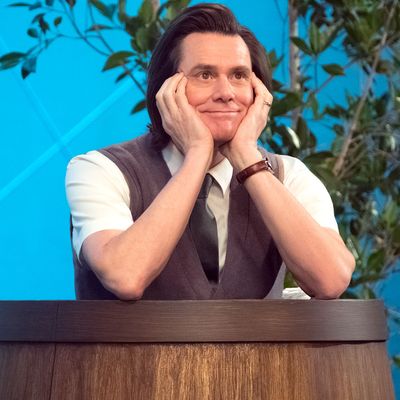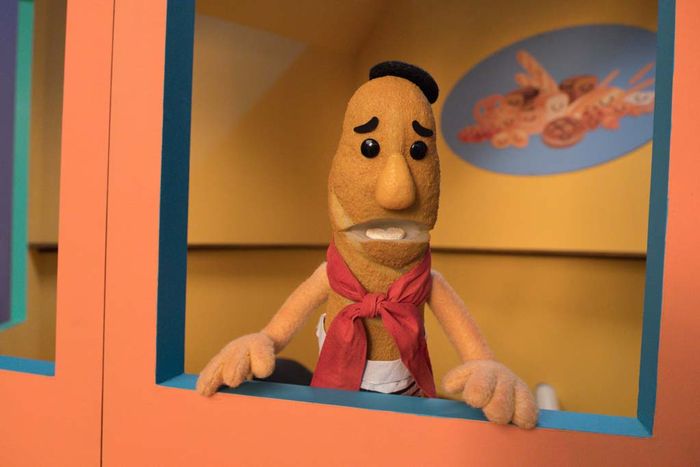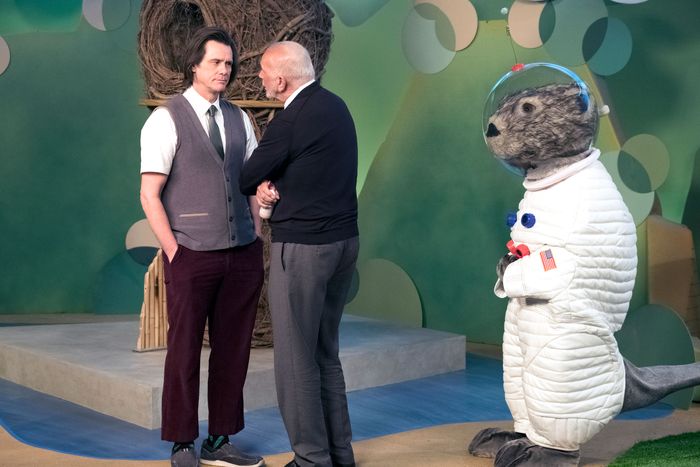
If you had walked on the set of Jim Carrey’s new Showtime series Kidding last spring, you might have thought you were in the wrong place. Instead of the usual premium-cable backdrops, you’d be standing inside a brightly colored children’s television show — in the world of Kidding, it’s the show that Jeff Piccirillo, a.k.a. Jeff Pickles (Carrey) has hosted for 30 years on Columbus, Ohio, public broadcasting — where you might run into the likes of a sad baguette named Ennui Le Triste, an otter in a spaceship made of twigs, or a singing ukulele called Larry. You’d also spot Mr. Pickles’s living room and the pickle barrel that transports him to Pickle Barrel Falls, an enchanted place that connects Uke-Larry, Astronotter, Ennui Le Triste, and each of their distinct homes to the rest of the puppets in Mr. Pickles’ Puppet Time.
“It’s more beautiful than walking onto the set of, say, a sitcom you’ve written, because you’re walking into pure magic,” said Kidding creator and showrunner Dave Holstein of the children’s show within the show. “It’s just pure imagination. You walk in and there’s this magical living room. It was really emotional, frankly, seeing it for the first time. It’s a place that attempts to make someone’s childhood better and that’s a fun place to work.”
Holstein and Kidding’s team of writers and crew built Mr. Pickles’ Puppet Time from the ground up as if it were a real TV show, and as if it were a cultural institution like Mister Rogers’ Neighborhood. “We really wanted to build a children’s show that could be a legitimate children’s show because it meant that our character Jeff was sincere. He is not something you usually see on premium cable, which is a main character who is just really kind and doesn’t want to kill hookers. And to sell that reality, we had to write a love letter to children’s television and not make a cardboard version of it.”
It all started with the name Mr. Pickles. Holstein began writing Kidding when he was a writer on Weeds (hence the hooker reference) and became intrigued by clips he saw of Mr. Rogers never breaking character outside of his show. He wondered what Mr. Rogers would be like if he allowed himself to get angry, and then came up with the idea of an optimistic, kind, and popular children’s TV host who must confront a family tragedy. The host’s name came to Holstein as he played with the last name “Piccirillo” and imagined the fun he could have with it: “He could do things like sign pickle jars for fans. It just seemed like, really, with his name being Piccirillo, he just worked with what he had.”
But Mr. Pickles’ Puppet Time was not fully developed as a show in Holstein’s first draft, so when he opened his writers room, he asked if anyone knew writers on Sesame Street, figuring they’d need the touch of an experienced children’s programming writer. “It wasn’t just for the sets and the puppets, but also the language you use when talking to children on television,” he said. “There’s a real specificity to what you do or don’t say, and I wanted to make sure we were abiding by that every step of the way.”
As it turned out, executive producer Michael Aguilar had a connection to Joey Mazzarino, the 23-time Emmy-winning Sesame Street head writer and puppeteer who played Murray Monster. Mazzarino, who left Sesame Street in 2015, read the pilot and was captivated by the question of what a Mr. Rogers–esque figure might be like on camera versus off. He agreed to come onboard as a story editor. “I worked with Bob from Sesame Street, whose real name is Bob and so many people know him as the TV icon. And then, he’s there just hanging out with you and being a real person,” Mazzarino said. “On TV, nobody gets to hear Bob say the F-word, but I do. Not that he curses crazily, but these are real people. I just thought it was interesting to see the difference between what America sees and the real flesh and blood human beings outside of that.”
When Holstein opened up the first discussion in the writers room about Puppet Time, Mazzarino had him convinced with his first pitch for Pickle Barrel Falls. “When he said that, I knew we were in it,” Holstein said. “It took him 15 seconds to come up with that.” Mazzarino said he’d actually been riffing in his head for a week or two about Mr. Pickles’s identity when the image of a pickle barrel emerged, but then it all just fell into place: Mr. Pickles would leave his living room, hop in a parachuted pickle barrel, and sail the river down a waterfall to the town of Pickle Barrel Falls, which leads to all of the different lands where the puppets live. “It’s like breathing for me to come up with puppet characters,” Mazzarino said. “I just love it.”
For the first season, the writers came up with a dozen puppets, each with its own backstory to represent a feeling or frustration a child might have. Ennui Le Triste, the sad French baguette with the cheese mouth who resides in Trifle Tower, was a crew favorite; Astronotter lives on Launchpad Lake; Sy the Wide-Eyed Fly is eternally curious and loves everything. “A lot of the stuff in Puppet Time comes from Jeff’s life,” Mazzarino said. “We were building the world of Puppet Time around who Jeff Pickles was and what he went through.”
Even Carrey, who serves as an executive producer, contributed to the roster of puppet pals: He invented the Oops, a puppet that personifies giving children the permission to make mistakes, and added tribal tattoos for Uke-Larry to make that puppet more Hawaiian. “There are little things you’d never notice. Oops is always making mistakes, so the tag on his sweater is inside out and his face is crooked,” Holstein said. “Jim had a lot of little details that I really like.”


Originally, Astronotter was a super penguin, but Carrey thought he looked “too pedestrian,” so Mazzarino revamped the puppet as an astronaut whose rocket ship is made of twigs. The writers had to nix Confetti Yeti — a puppet that, naturally, sneezed confetti — because of a video game with that same name. “I was upset about that one, I thought it was really fun,” Mazzarino said. “But then we came up with Hopscotch the Sasquatch, a Bigfoot that plays hopscotch and every time he jumps, the world shakes.”
To create Puppet Time’s nostalgic aesthetic, production designer Maxwell Orgell researched 1960s- and 1970s-era French stop-motion animation series, like Les Aventures de Colargol, Le Manège Enchanté, and The Magic Roundabout. Then he listened to Mazzarino’s ideas and director Michel Gondry’s interpretation of the script before creating photo renderings of the different realms where the puppets live.
“Really figuring out that structure — each puppet has its own world and they interact through the river system — was pretty amazing,” Orgell said. “The hyperform of normalcy in the real world and the supersaturated fantasy world need each other to keep things interesting. Otherwise, one just turns into candy and the other is too depressing by itself. I don’t think any of us knew how far we would go to flesh out Puppet Time.”
Production worked with a dozen puppeteers to bring the puppets to life. Each of the puppets’ homelands needed to fit in a cohesive universe, too. “That was the biggest challenge: How to create the intimate space in Mr. Pickles’s living room and create an adventure for the viewer?” Orgell said. “They all needed to feel like they were part of the same thing; like if one person made them, they should feel like they all came from the same painter.”
Behind the scenes, everyone loved Mazzarino’s idea of Mr. Pickles traveling in a pickle barrel down a waterfall to Pickle Barrel Falls, but filming that sequence, which first appears in the second episode, became one of production’s trickiest endeavors. “There were so many ways it could have been addressed,” Orgell said. “It was a rear projection at one point, but it ended up being traditional Michel Gondry. I was so glad we did that instead of going into an animation sequence or something of that nature.”
Gondry chose to make the transition using basic animation made of cardboard, glue, and a miniature photograph of Mr. Pickles. A small paper barrel transports the tiny Jeff cutout over a waterfall. “The intention was to take a very low-fi approach to a children’s show,” Holstein said. “It wasn’t about crazy colors or lab cuts or fast cuts. It was about creating a sense of a show built from a child’s imagination. Each time a child watches that, they might be inspired to make something like it at home.”
After all of that work, Holstein and Mazzarino said they’d love to produce an entire episode of Mr. Pickles’ Puppet Time as an episode of Kidding. “It’s incredibly emotional to watch not just the world you wrote in a script come to life, seeing a character’s house, for example, but seeing a character’s imagination come to life, too,” Holstein said. “It makes it a real person. To see your character’s imagination in three dimensions around you, and you’re walking through their head as you’re seeing all these puppets they came up with, it’s a real magical feeling.”


